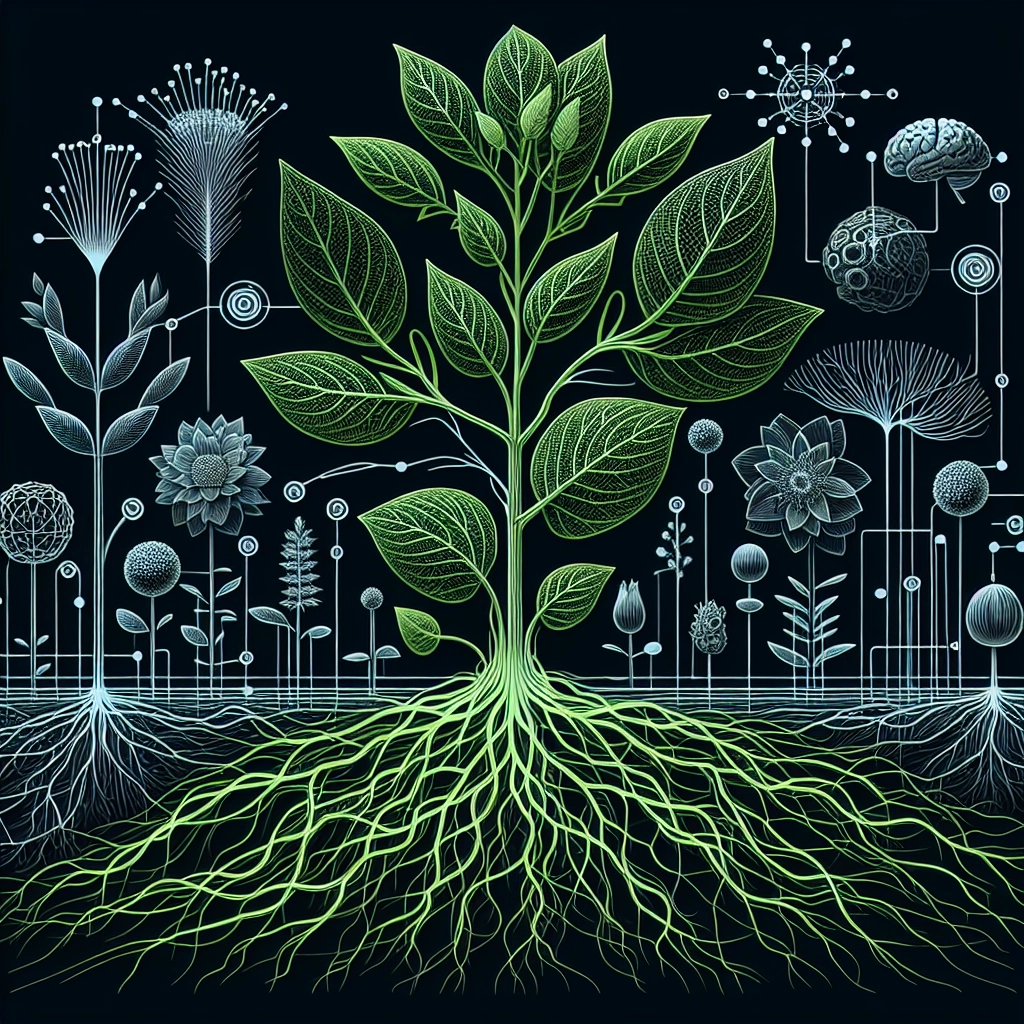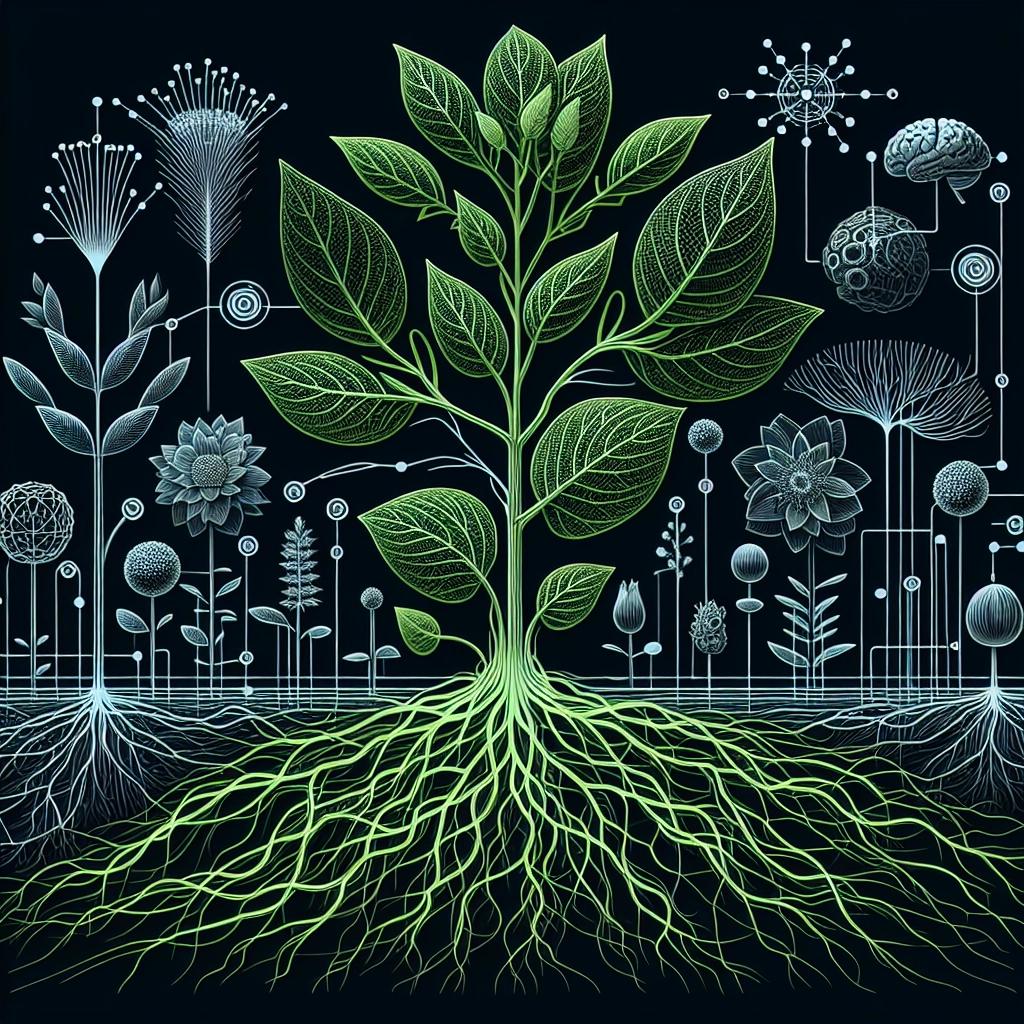Plant Neurobiology: Exploring the Intricate Communication Networks in Plants 🌿🧠
 Quantum Cyber Solutions
Quantum Cyber Solutions

Published on
Tuesday, May 21, 2024
Plant Neurobiology: Exploring the Intricate Communication Networks in Plants 🌿🧠
=====================================================================================
Authors

Name
Eric deQuevedo 😄
Twitter
🌿 Plant Neurobiology: Exploring the Intricate Communication Networks in Plants
In the intricate web of life, plants have evolved sophisticated systems to perceive and respond to their environment. This field, often referred to as plant neurobiology or plant signaling and behavior, uncovers the remarkable ways in which plants sense and interact with their surroundings. Let's delve into the mechanisms of plant perception, the parallels with human gut feelings, and the wisdom of indigenous traditions that align with these scientific findings.
📡 Plant Sensory Perception: The Basis of Plant Neurobiology
Plants, although devoid of nervous systems, exhibit an extraordinary ability to sense and respond to various environmental stimuli. Key aspects of plant sensory perception include:
- Photoreception: Plants utilize photoreceptors to detect light quality, direction, and intensity, optimizing their photosynthesis and growth patterns.
- Gravitropism: Through the perception of gravity, plants orient their roots downward and shoots upward, ensuring proper growth.
- Thigmotropism: Plants respond to physical touch and mechanical stimuli, such as climbing plants wrapping around structures for support.
- Chemoreception: Plants detect chemical signals from their environment, including nutrients, toxins, and signals from other organisms, facilitating interactions like allelopathy.
🧬 Plant Communication: A Silent Yet Powerful Language
Plants communicate with each other and other organisms through various signaling mechanisms:
- Chemical Signals: Volatile organic compounds (VOCs) released by plants can attract pollinators, repel herbivores, or warn neighboring plants of impending threats.
- Root Exudates: Chemicals secreted by plant roots interact with soil microbes, enhancing nutrient uptake and providing protection against pathogens.
- Electrical Signals: Plants can transmit electrical signals in response to environmental changes, akin to neural communication in animals, triggering systemic responses throughout the plant.
🧠 Plant Learning and Memory: Beyond Simple Responses
Research by scientists like Monica Gagliano has revealed that plants might exhibit behaviors analogous to learning and memory:
- Habituation: Experiments with Mimosa pudica (the sensitive plant) have shown that repeated exposure to a non-harmful stimulus (like dropping) leads the plants to stop closing their leaves, indicating a form of learning.
- Conditioning: Plants can associate specific environmental cues with certain outcomes, similar to classical conditioning in animals, suggesting a primitive form of memory.
🌿 The Gut-Plant Connection: Microbiomes and Gut Feelings
A fascinating aspect of this field is the potential link between plant neurobiology and human gut feelings. Our microbiome, a complex community of microorganisms residing in our gut, is largely influenced by plant-derived nutrients and compounds. This symbiotic relationship between humans and plants might explain the phenomenon of gut feelings—intuitive sensations arising from the gut.
The gut-brain axis, a bidirectional communication network between the gut and the brain, is influenced by microbial activity. Plants contribute to this system by providing essential nutrients and bioactive compounds that shape our gut microbiota. This intricate interplay suggests that our "gut feelings" could be a manifestation of the evolutionary connection between plants and animals, mediated by our microbiome.
🌍 Spiritual Insights: Indigenous Wisdom and the Sacred Web of Life
Indigenous traditions worldwide often emphasize the interconnectedness of all life forms. The notion of Mother Nature as a nurturing force reflects a deep understanding of the symbiotic relationships that sustain ecosystems. Indigenous wisdom teaches that plants, animals, fungi, and microorganisms are all part of a sacred web of life, each playing a crucial role in maintaining balance and harmony.
The parallels between the veneration of nature in indigenous cultures and the scientific findings in plant neurobiology suggest a profound, intuitive knowledge of the natural world. This holistic perspective encourages us to approach nature with reverence and to recognize the interconnectedness of all living beings.
🔬 Cleve Backster's Experiments: Plants and Human Intentions
The idea that plants can read human minds is largely associated with the work of Cleve Backster, who conducted experiments in the 1960s suggesting that plants could perceive human intentions. Backster, a polygraph expert, claimed that plants connected to a polygraph showed significant reactions when he merely thought about harming them, such as burning their leaves. This phenomenon, which he dubbed "primary perception," led him to believe that plants could sense human thoughts and emotions.
Backster's experiments involved attaching polygraph electrodes to plant leaves and observing changes in electrical resistance in response to his intentions. He reported that plants exhibited reactions similar to those of humans experiencing stress, such as when he pretended to burn a leaf but did not actually do it.
However, Backster's methodology and conclusions have been widely criticized for lack of scientific rigor and proper controls. Skeptics argue that his findings could be attributed to various external factors, such as changes in humidity or temperature, rather than any form of plant consciousness or telepathy.
More recent discussions in the scientific community focus on plant communication and responsiveness to environmental stimuli rather than mind-reading capabilities. Plants are known to respond to light, touch, and even sound waves, which indicates a form of sensory perception, but this is a far cry from the notion of mind reading. Researchers like Monica Gagliano have explored plant communication and suggested that plants can exhibit behaviors that resemble learning and memory, though these behaviors are interpreted within the framework of biological responses rather than telepathy.
In summary, while the idea of plants reading human minds is intriguing and has been popularized by anecdotal and experimental accounts like those of Cleve Backster, it lacks robust scientific support. The current understanding of plant perception and communication is grounded in their responses to physical and environmental stimuli rather than any form of psychic connection with humans.
🌿 Conclusion: Embracing the Complexity of Plant Life
The exploration of plant neurobiology reveals the remarkable complexity and sophistication of plant life. By understanding how plants perceive and respond to their environment, we gain insight into the evolutionary processes that shape all living beings. The potential connection between plant signaling mechanisms and human gut feelings underscores the deep, evolutionary ties that bind us to the plant kingdom.
As we continue to unravel the mysteries of plant perception, let us embrace a holistic and reverential approach to the natural world. Recognizing the sacred connections that bind us to plants, fungi, and microorganisms can foster a deeper appreciation for the diversity and resilience of life on Earth.
In the end, the study of plant neurobiology not only enhances our scientific understanding but also invites us to contemplate our place within the greater ecosystem. It challenges us to view ourselves as integral parts of the intricate web of life, connected to all living beings through the shared language of nature. 🌿🔬🌍
Discuss on Twitter • View on GitHub
Tags
Plant Neurobiology
Plant Perception
Microbiome
Gut Feelings
Electrophysiology
Plant Behavior
Symbiosis
Speculative Biology
Indigenous Wisdom
Previous Article
Next Article
The Fungal Connection: Exploring the Evolutionary Intertwining of Animals, Fungi, and Plants 🍄🌿🐾
Subscribe to my newsletter
Read articles from Quantum Cyber Solutions directly inside your inbox. Subscribe to the newsletter, and don't miss out.
Written by
